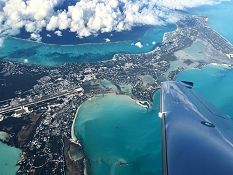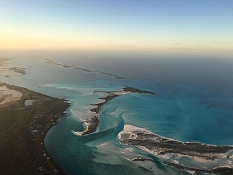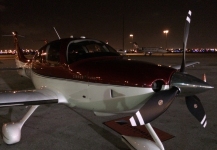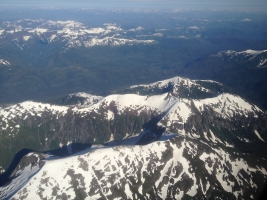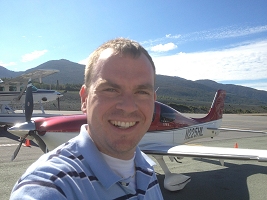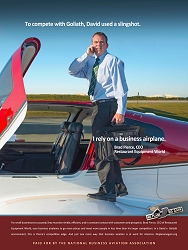Flying My Cirrus Aircraft to Puerto Rico
When you fly as much as I do traveling throughout the country, it takes a lot to sit back and say “Wow, that was an amazing experience” reflecting on a flight. This past weekend was one such experience flying from Orlando down to Puerto Rico in my Cirrus SR22 Aircraft, so I thought I’d share a blog post about it along with photos from my journey.
I left Orlando and flew directly to Exuma (MYEF) which took roughly 2 hrs. The tower services were a bit strange in that they only serve in an “advisory” capacity, basically providing winds and nothing else. Approaching the island was gorgeous despite some scattered clouds throughout the area. There’s a 7,000 foot runway with only one turnoff (no taxiways) being about 5,000 feet down, so I’d recommend landing long – the condition of the runway itself was great. The folks at Odyssey knew I was coming in ahead of time for a quick turn fuel stop ($7/gal) and pulled up the fuel truck as soon as I turned off the engine. I walked into the FBO, a few minutes later was fueled and cleared customs ($50 fee – never talked to anyone other than the friendly person at the desk). My expedited customs arrival/departure was due to e-mailing my passport and info ahead of time, didn’t even need to pull out my passport since they already had it. I was airborne again about 20 minutes after I’d landed, a really quick turn.
Heading Southeast leaving Exuma was some of the prettiest flying I’ve ever done over water and islands. The Turks and Caicos were especially pretty – that’s actually where I’d planned my fuel stop originally, but they wanted $150 for customs for the stop so I thought I’d save $100 enjoying the view from above. Once I was South of the Turks and Caicos was where it got a bit more sparse. You’re still communicating with Miami air traffic control, but there’s no land in sight for a long, long time as you cross hundreds of miles of open water. Total flight time was around 3.5 hours, passing Cuba, Haiti and the Dominican Republic along the way. I had a maritime survival equipment onboard including a life raft (thanks to my friend Rich for inspiring that purchase), a marine radio, personal locator beacon (PLB), etc. Despite being well prepared to take an unexpected cruise, I’m glad all that preparation was for nothing. Just before reaching San Juan, Puerto Rico, I was switched over to their approach control from Miami. I landed at Fernando Luis Ribas Dominicci Airport (TJIG) which is the executive airport about five miles from the commercial airport (TJSJ). My landing was smooth as silk and the tower air traffic control services were flawless. Since I’d stopped in the Bahamas, I was now considered an international flight returning to the US (even though I was in Puerto Rico). My stop at the US Customs office took all of 2 minutes and was uneventful. The FBO (Million Air) greeted me at customs, unloaded my bags, and towed the airplane next door to their facility. Then they pulled up a brand new Mercedes and the line guy drove me about 10 minutes down the road to my hotel. Amazing service to say the least!
I had several days of successful business conference meetings then it was time to return to Florida. On my departure from Puerto Rico, I once again passed through Million Air and had another fantastic experience. Smiling faces who were over-the-top helpful – truly one of the best FBO experiences I’ve ever had anywhere. My IFR (instrument flight rules) flight plan was filed and I was ready to go. Here’s when I discovered a quirk compared to some of the other flying I’ve done in the states. I filed fixes on the airways all the way back to Exuma. Clearance rejected my flight plan however because they wanted the actual airway listed too. Funny thing is the airway was a straight line between the two fixes, but I re-filed with the exact same route (this time spelling out the airway) which then made everyone happy. My flight back to Exuma was equally as beautiful as on the way down. This time there we no clouds though which made for even better views out the windows of my Cirrus.
It was late in the day as I landed in Exuma just before sunset. No big deal, or so I thought. I didn’t realize that when the clock struck 6:00, that meant there were no more departures – even though it was still perfectly clear daylight out. The FBO attendant told me that I was stuck there for the night, unless I wanted to pay an extra $86 fee for an after hours departure. So, at about 6:04, I paid my $86 and got my clearance to depart after hours – still with nothing more than a “wind check” advisory for my departure. The way I figured it, my cost to stay overnight would have far exceeded the $86 so it was a no-brainer to pay it and chock it up to a lesson learned to fly earlier in the day.
I cleared US customs at their brand new customs facility at Ft. Lauderdale Executive Airport (FXE). They customs agents there were fantastic! They asked if I had any fruits, seeds, nuts, etc… right about that time I pulled out my snack bag I’d packed and realized I had a trail mix called “Fruit and Seed Mix”. I’d just hit a double home run with my snack choice! The customs agents were great and it wasn’t an issue as they were still sealed (and discarded) but did make for a good laugh.
On a trip like this the one thing that I’d stress is to make sure you’ve got all your US Customs eAPIS (Electronic Advance Passenger Information System) filings done ahead of time which just makes everything so much easier. You’ve got to file your outbound US departure to Exuma, your inbound from Exuma to Puerto Rico, then the same in reverse on your return flights. Between the US, Bahamas and Puerto Rico you’ll be clearing customs four times on the trip and file four eAPIS reports. I use the FlashPass App on my iPad which makes it quick and easy to do. It’s good to have the customs numbers for your intended airports handy too so you can give your US Customs Notices of Arrival as necessary. Also, for anyone wishing to take this trip looking for alternate airports to file as well just in case a diversion becomes necessary – in the Bahamas you’ve got Stella Maris (MYLS) and in San Juan you’ve got Luis Munoz Marin International Airport (TJSJ). Though it’s worthwhile noting at TJSJ, I was quoted $300-$600 for a ramp fee, but they wouldn’t be able to tell me exactly what it would really cost until I arrived. Needless to say, I chose to go to the executive airport instead – and made an excellent choice choosing Million Air. They communicated quickly with me over e-mail ahead of time and knew exactly what to expect in terms of fees and services provided. If you go there, say hello to Juan the manager for me, really nice guy who runs a first class operation. There’s also an excellent Cirrus Authorized Service Center on the field (Caribbean Aircraft Maintenance) in case you have any mechanical issues which need to be addressed.
Overall, this is one of those trips that goes down in the books as a truly great experience that reminds me of why I fly a Cirrus. All the other folks at my conference took airlines down there. I’m sure several thought I was crazy for flying myself – until I chatted about my adventure and showed them some pictures of my journey… then they wished they’d tagged along with me instead! This is what living the Cirrus Life is all about, the experiences and joy it adds to our lives!
Feel free to reach out to me if you’re ever thinking of flying down to Puerto Rico and will be happy to chat further about my experience. Definitely looking forward to taking another trip down there (and beyond) soon!



